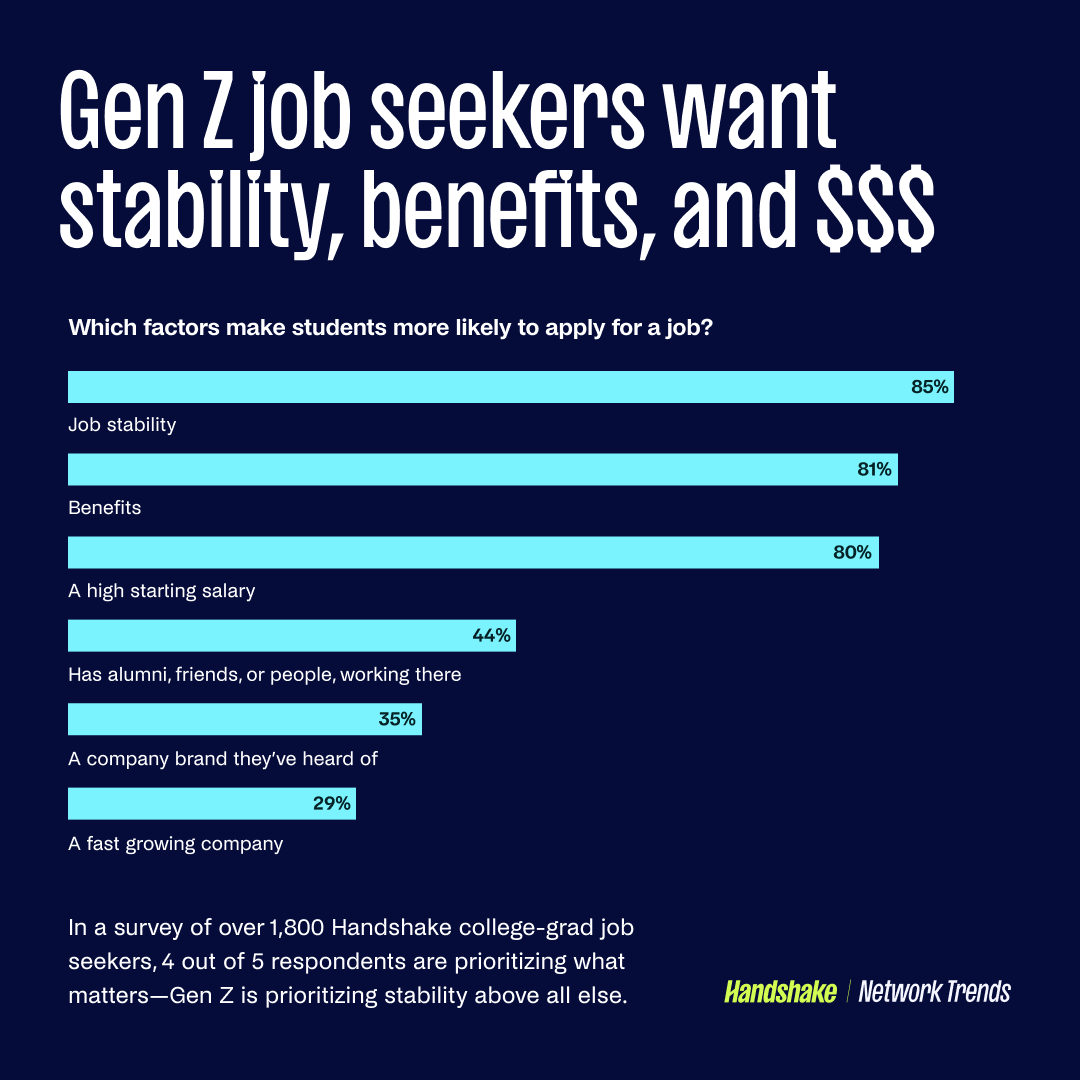
?Job stability is the top priority of Generation Z college graduates, followed closely by benefits and a high starting salary, according to the sixth annual Network Trends report from Handshake, an online recruiting platform for higher education students and alumni. Pay transparency is also very important to these new workforce entrants.
The findings are from an online survey Handshake conducted Aug. 30-Sept. 28, 2022, with 1,853 job seekers who were college students and upcoming graduates; 615 four-year colleges and universities were represented.

Job Stability
The definition of job stability varies from job seeker to job seeker, but most survey respondents are concerned about the many layoffs they are reading about in the news, said Christine Cruzvergara, chief education strategy officer at San Francisco-based Handshake.
“That’s unsettling,” she acknowledged. They want to work for long-standing companies that “have been through ups and downs and managed to stand the test of time.”
Job stability is a concern that has grown among respondents; a Handshake survey conducted in fall 2021 found 74 percent rated it as important when applying for a job, Cruzvergara noted. Along with wanting that sense of stability is the desire for opportunities for career advancement or cost-of-living raises.
“What’s really fascinating is this class’s focus on stability.” Millennials, Cruzvergara noted, “got a bad rap for job hopping,” but members of Generation Z, who have lived during tumultuous times and watched their parents deal with the 2008 recession, seek a longer tenure with an employer.
Salary Expectations
Students also have high salary expectations, although that varies by gender and field of study. Engineering students had the highest salary expectations among the Class of 2023, while female students overall expect a $6,200 lower average salary than their male counterparts.
Other surveys also noted this trend. 2022 survey findings released by Otta, a London-based job search platform, found women in nonsenior software engineering, data and product roles set minimum salary requirements of 19 percent to 20 percent less than men, Forbes reported. Minimum salary expectations were somewhat better for marketing and HR positions, but women in those fields set their minimum salary requirements 7 percent to 10 percent lower than men.
“That’s why salary transparency around [pay] ranges is so important, because it’s the first step in
re-educating everybody on what’s reasonable, so both men and women have a better picture” of the pay range of a position, Cruzvergara told SHRM Online.
Pay transparency laws in states like California, Colorado, New York and Washington mean employees and candidates have more ability to achieve competitive pay. At least 14 U.S. states and five cities have passed laws requiring such transparency, All Things Work reported in October 2022.
However, how an employer discloses pay varies. In California, employers must include a pay scale or hourly range in job postings. But in Maryland, job applicants must request the pay range for a position, according to Mercer, a professional services firm.
“Pay transparency is not just a legal and compliance issue. It’s about employers communicating pay practices that help employees understand their salary in the context of the market and business realities,” noted Muriel Taing, Mercer senior compensation consultant.
“The reality is that many employees and candidates don’t have this context to understand how pay is determined, how pay ranges are created and how they can expect to move through the pay range. Visibility into pay ranges is creating a ripple effect, with broader conversations needed to help employees understand how they should be thinking about pay.
Noted Cruzvergara, “Students are more likely to apply [for a job] if they see a salary range. Women and students of color are attracted to that” Underrepresented students, including first-generation college students, don’t have the network of people who can help them navigate salary negotiations, she added.
Benefits
Workplace flexibility is one of the benefits new graduates are looking for in an employer, according to Cruzvergara.
“More students ask about flexibility in their interviews. … Most are not looking for a fully remote experience. They want to be in the office, they want to make new friends. They also would love to not go into the office five days a week,” she said, pointing to the cost of commuting.
Employers can appeal to students, Cruzvergara suggested, by offering commuter stipends or hybrid work schedules. She also advised employers to:
- Talk about the mental health benefits they offer.
A survey of 2,500 employees conducted in 2022 by Securian Financial found that Generation Z and Millennials are more likely to value mental health benefits compared to Generation X and Baby Boomers.
- Be clear in job descriptions about other benefits, such as career paths and mentorship programs.
*Provide a great onboarding experience and “make the implicit explicit.” An organization’s cultural norms can be hard for young employees to grasp; communicate your organization’s expectations, such as whether employees are expected to keep their cameras on during Zoom meetings, if voicing ideas and opinions is welcome early in their tenure, and if so, how they should be communicated.

